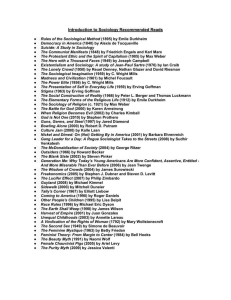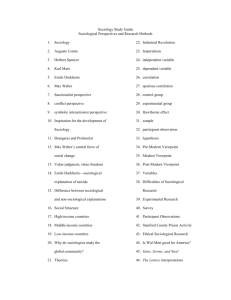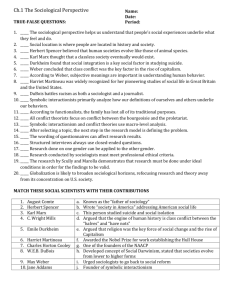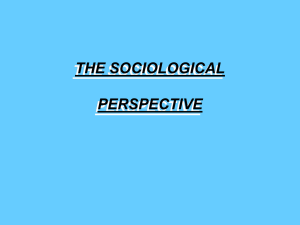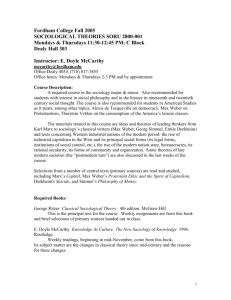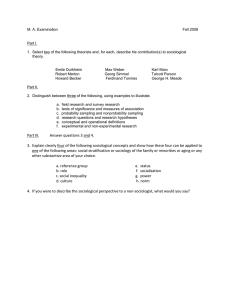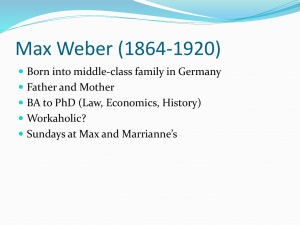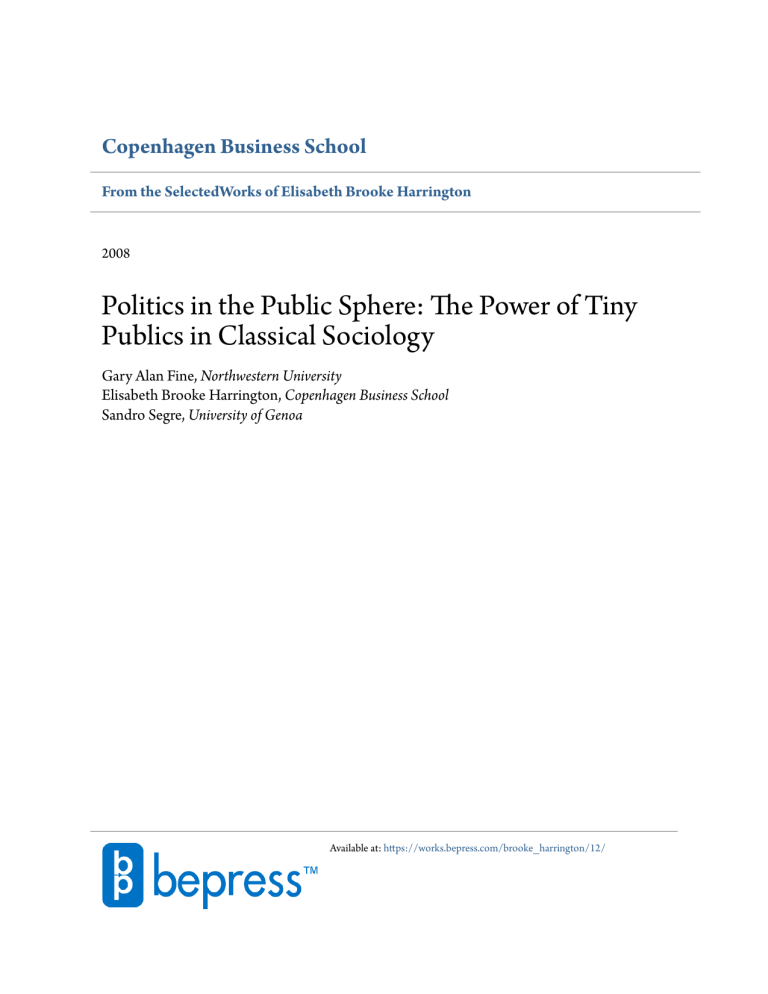
Copenhagen Business School From the SelectedWorks of Elisabeth Brooke Harrington 2008 Politics in the Public Sphere: The Power of Tiny Publics in Classical Sociology Gary Alan Fine, Northwestern University Elisabeth Brooke Harrington, Copenhagen Business School Sandro Segre, University of Genoa Available at: https://works.bepress.com/brooke_harrington/12/ Saggi Politics in the Public Sphere The Power of Tiny Publics in Classical Sociology by Gary Alan Fine, Brooke Harrington and Sandro Segre doi: 10.2383/26561 As Fine and Harrington [2004] have argued, the relationship between individuals and the social systems which they inhabit is shaped within face-to-face groups. Early work by Habermas and others on the development of the public sphere suggests that interactional arenas – salons, taverns, coffee houses, or other small group modalities – create arenas of discourse in which civil society is enacted and made concrete. However, this research has not led – as one might have expected – to the explicit theoretical attention by political sociologists to small groups and their political incarnation as “tiny publics.” In this article, we make the case for a stronger linkage between the two realms of theory, arguing that political sociology requires the conceptual frameworks of social psychology to explain how meaning and action are constituted in civic life. To illustrate our argument, we survey the work of classical sociological theorists who have analyzed the connections between groups (“tiny publics”) and the systems in which they are embedded. We focus on the arguments of Simmel, Durkheim, and Weber on the linkages between individuals and communities, but conclude by presenting a case for the role of small-groups within American political culture. Although we begin with sociology’s founding theorists – a group of scholars well-recognized by macro-sociologists, but often downplayed in the social psychological literature – the importance of tiny publics in sociological theory does not end with these early writings, but remains at the core of work by mid-century theorists (such Sociologica, 1/2008 - Copyright © 2008 by Società editrice il Mulino, Bologna. 1 Fine, Harrington and Segre, Politics in the Public Sphere as Blumer, Goffman, Garfinkel, and Homans), and contemporary theorists alike (including Bourdieu, Giddens, Alexander, and Collins).1 Small groups and political sociology x While institutions, organizations and other macro-social units are often construed as determinants of collective action and contentious politics, we argue that politics ultimately depends upon the emotional entrainment, performance rituals, and impression management that occur within groups. This synecdoche of social life, in which the part is taken for the whole, means that the actions of individuals are interpreted as expressions of collective action. Thus, former American First Lady Hillary Clinton could argue that the 1998 impeachment crisis that occurred during her husband’s Presidential administration was driven not by the actions of individuals, but by a “vast, right-wing conspiracy.” The underlying assumption is that the behavioral choices and motivations of actors have recognizable parallels in the behavior of groups, organizations, and other collective units. Although individuals need not always mirror the organizations to which they belong, the linkage is routinely assumed and is grounded in common-sense interpretations about the relationship of actors to organizations. Implicit in our argument is an assertion that may be foreign to some political sociologists: that face-to-face situation can be meaningfully generalized. This is essential for legitimating and justifying the theories and methodologies that depend on close investigation of a particular scene, whether that scene is observed through controlled laboratory experimentation or ethnographic fieldwork. If cases only stood for themselves, sociology would have little predictive or analytic power, and would be limited to local descriptions. From the standpoint of political sociology, the value of examining small groups may be clearest when considering questions of institutional action: for example, why and how do political organizations act? How do institutions overcome inertial forces? And how are problems of collective action resolved? Inevitably, institutional actions are a combination of the constrained and channelled choices that groups of individuals make, and that groups of individuals enforce. This process can be illustrated vividly by examining how civil society – an institutional formation unconstrained by formal lines of authority or power relations – is created by means of an active public sphere. In the writings of some political scientists, the construct of the public sphere x 1 2 We hope to address the more recent directions in a subsequent manuscript. Sociologica, 1/2008 seems abstracted from individuals. But this elision only begs a further question: How are ideology and social order formulated? Social psychological theory prompts sociologists to analyze civil society as a complex of smaller spheres, each whole and analytically distinct in themselves, like a fishbowl filled with marbles. In the same way that a network can be understood as a constellation of tight-knit “clumps” of actors [Fine and Kleinman 1979; McPhail 1991; Aveni 1977] the public sphere can be parsed into its small-group components in order to gain explanatory power over political phenomena, while not forgetting linkages among groups. From this perspective, we understand societies to depend upon the ongoing activity of interconnected groups participating in civic life. Public spheres also depend upon the existence and availability of arenas for (inter)action. This suggests why the right to free assembly is a defining characteristic of democratic polities; in contrast, authoritarian regimes are marked by their ongoing hostilities with and attempts to control “tiny publics” in their various forms. In 1675, for example, fears of growing political instability led King Charles II of England to issue a Proclamation for the Suppression of Coffee-Houses, shutting down the small group settings widely believed at the time to be “dens of subversion, where social classes promiscuously mingled and spread the rumours published in gazettes and pamphlets, where ‘every little fellow in a camlet (a kind of outerwear) takes upon him to transpose affairs both in church and state, to shew reasons against acts of parliament, and condemn the decrees of general councils’” [Teverow 2003]. More recently, despots in places like Myanmar forbid or severely restrict citizens’ right to gather together, as well as placing restrictions on access to the internet for reasons similar to those of Charles II. Such policies are not designed to control individuals, who pose little threat, but to limit the formation and activities of groups. Even when political oppression focuses on an individual – such as dissident Anh San Suu Kyi in Myanmar – the object of keeping her under house arrest is to prevent her from mobilizing the civic groups that could pose a meaningful threat to the regime. From online chatrooms to more traditional venues, like coffeehouses, clubs and congregations, these “third places” [Oldenberg 1989] provide the necessary spaces in which focused talk can occur and lines of action develop. A public sphere requires a set of known others, focused attention, shared knowledge (stories, gossip, rituals, traditions) and a space in which regular interaction can occur. Aldon Morris’ analysis of the Black Southern church as the organizational and ideological crucible of the civil rights movement vividly illustrates this micro-macro link [Morris 1981]. Churches and other institutional structures can communicate with multiple small groups simultaneously to catalyze political action, thereby enabling “tiny publics” to establish their presence in the public sphere. The role performances and frames that emerge 3 Fine, Harrington and Segre, Politics in the Public Sphere within interactional units can be magnified until they attain the status of “public opinion.” Politics is a domain of negotiated order in which frames, roles, and lines of action are crafted and contested. Even when these roles or actions are linked to institutional requirements, they are animated by individuals. At one level, it makes perfect sense for a political sociologist to treat “the state” as the principal unit of analysis, without seeking to explain agency on the part of the individuals who inhabit government institutions. But this view obscures the micro-level processes through which action is selected, enacted and enforced, to the detriment of theories’ explanatory power. For example, without accounting for agency at the micro-level in political institutions, we lose much of our ability to account for the conflict and change so characteristic of the political realm. Although much discussion in contemporary sociology has overlooked the mesolevel of small group interaction, scholars must take account of “tiny publics” as a means to understand social structure as it operates in situ. Core constructs such as institutions, organizations, and social movements are grounded implicitly in theories of small group interaction, and these social psychological foundations should be acknowledged. At the level of group interaction, we observe individual behavior aggregating into society, and it is this metamorphosis – the process by which the individual level of analysis rises to the group level and ultimately to the level of macrostructures like institutions – that constitutes the core concern of sociology. Although often perceived as a disciplinary specialty, social psychologists labor under the same mandate as their colleagues in macro-domains of sociology: to explain the process of social order. How is society constituted? In this analysis we attempt to apply an understanding of group dynamics and micro-cultures to explore the role of political action within the public sphere, arguing that collective action is generated within the confines of tiny publics. As social psychologists, we argue for a position labelled “sociological miniaturism” [Stolte, Fine, and Cook 2001]. This approach is a means of interpreting social processes and institutions through a fundamentally micro-sociological lens, permitting the analysis of large-scale social forces by means of the investigation of smallscale interactional domains. Specifically, we posit that sociologists must account for interpersonal situations as the sites in which broader social forces, properties, and processes are enacted in practice. Micro-situations can simulate the dynamics of larger social units: that is, macro-sociology and micro-sociology recursively provide the foundations for each other’s existence [Collins 1981; Fine 1991]. The perspective of “sociological miniaturism” assumes that processes transcend levels of analysis in several ways. First, phenomena that occur at one level of analysis 4 Sociologica, 1/2008 (for instance, the interpersonal level) will routinely be found on other levels (for instance, the institutional or interorganizational) [Harrington and Fine 2000]. Second, our approach assumes that individual behavior can be treated, at least at certain moments, as representative of larger social entities. The individual can stand in for the group, and, more significantly, is treated by others as representing that group. We argue that understanding “tiny publics” [Fine and Harrington 2004] – domains of discourse that refer to the normative and value organization of communal systems – provides an opening for interpreting the local processes by which societies are built. Our stance in this account is to suggest that the basis for such an analysis in inherent in social theory, beginning with the classical sociological writers, including Simmel, Durkheim and Weber. By presenting a vision of political sociology grounded in small group dynamics, we can explore how microsociology must inevitably be an essential part of sociological theory. The classical impulse in sociological miniaturism x A close reading of their texts reveals that classical social theorists, especially Simmel, Durkheim, and Weber, have dealt extensively with groups and micro-level processes. It is to the perspective of these theorists to which we turn, emphasizing the points on which they address models of “tiny publics.” Simmel x As Simmel has emphasized, the group possesses a life of its own, over and above that of subgroups and individual members. This life rests on the common will of members, and the group’s duration beyond the members’ lives. Trust connotes relations among a group’s members, as long as their mutual knowledge is neither complete (for trust would not be necessary), nor absent (for trust would not be reasonable) [Fine and Holyfield 1996]. Trust is a necessary condition for common action. In modern circumstances the determination of social positions and individual lives on the part of institutions and the public opinion has made impersonal, formal trustworthiness relevant, while personal knowledge has become less central. Business relations with customers are a case in point, as every customer is interchangeable and is treated accordingly. Because of their impersonal character, modern social relations differ from those of previous times. This holds true, however, only when social relations with other group members are of little significance. If this is not the case, as with guild members 5 Fine, Harrington and Segre, Politics in the Public Sphere in medieval times or partners in modern business firms, then close knowledge of the partner’s personality and life conduct has the greatest importance in all stages of the relationship. Such close knowledge is not customary in modern times, for the monetary economy and equal legal rights have made individual qualities and personal traits secondary in a great number of social relations: those, namely, in which feelings of faithfulness and gratitude have little significance and do not, therefore, promote stability [Simmel 1968, 438-447; see also Nedelmann 1983, 182-184]. This very large number of relations, on the other hand, has greatly promoted the development of such qualities and traits, since everyone is free to pursue relations with a plurality of individuals and groups to an extent that never occurred before. Modernity, in other words, is conducive to relations with the largest number of individuals and groups. The paradox is that groups still matter – and matter greatly – in conditions of modernity, but they may be more transient or less a part of one’s ascribed social position – or, given the ability of individuals to participate with more groups, the increase in interaction may produce a weakened affiliation with any one. Further, some groups may be treated as wispy communities – temporary and evanescent – but meaningful while they exist. The limitation of pre-established social circles restricted the development opportunities of individual personalities and social life in general. As this limitation no longer applies because of the social pervasiveness of market relations, unintended consequences have followed. The economic and legal institutionalization of social relations has produced a great uniformity of relations to economic and political systems, but at the same time economic and social differentiation has yielded the possibility, available in principle to all individuals, to select social relations and differentiated forms of cultural display. Mental processes may then be conceived as pertaining to individuals and social life as well. Social differentiation proceeds with the differentiation, cultivation and enrichment of the individual personalities, and also with society’s culture and “public spirit” [Simmel 1968, 571-572]. Simmel has emphasized the ambivalent effects of the prevalence of the money economy on groups, their members, and the development of public spirit and civil society. The existence of small groups and the relations within and among them are promoted, and at the same time impeded, by the money economy. On the one hand, as a consequence of its pervasiveness, interactions are frequently constrained by contractual stipulations. On the other, the number and variety of interactions are greatly increased within and across groups. In particular, the significance of business relations with strangers across groups is constrained, while increased with trusted partners within groups. There are, accordingly, two kinds of trust, the former being a prerequisite to commercial transactions, while the latter flows from non-commercial 6 Sociologica, 1/2008 relations, and in turn facilitates and strengthens them. The two kinds of trust correspond to different forms of aggregation into society and of institutional development. Commercial trust with trusted partners and strangers promotes civil society only indirectly, through its favourable effects on non-commercial relations. The money economy makes the number and existence of both types of relations possible [Simmel 1922, 369-386; Simmel 1968, 144, 263-264, 317-318, 383-384, 559-565; Simmel 1978, 331-354; Simmel 1984]. Durkheim x Like Simmel, Durkheim paid close attention to the impact of groups on interpersonal relations in the social and cultural contexts provided by modernity. As he maintained, this impact differs according to the extent to which both individuals and social collectivities are interrelated, and the frequency and contents of their interrelations. The Durkheimian concept of society’s moral or dynamic density is relevant in this connection. The concept refers to the mutual influences between individuals and between collectivities such as nations or groups [Durkheim 1998b, 238, 330; see also Lukes 1972, 168-170]. In Durkheim’s words, “moral life circulates through all its constituent relations” [Durkheim 1998b, 264] as a result and indicator of moral density. Feeling of solidarity involving both individuals and collectivities reach maximum intensity during particular ceremonial occasions. In the course of these events, people are physically assembled, stand in immediate relationship to each other, leave aside concerns that are usually more urgent, and participate actively and jointly in a socially regulated collective experience [Durkheim 1998a, 493, 497, 525; see also Rawls 2004, 336-338]. Moral density depends on society’s volume: namely, on the number of connections among individuals and among social aggregates. Therefore, it depends on the opportunities of mobility and potentials for interaction. Moral density presupposes an advanced and complex division of social labor, and is in turn a precondition to the development and differentiation of individual personalities, whose mental life becomes more articulated and flexible as a consequence [Durkheim 1998b, 237-267, 327-342]. The division of labor in society does not involve moral density, or any of its effects, if either of the following conditions obtains. Relations between individuals may be confined within collectivities, rather than across them. Also, their content may be limited, so that the range of interactions between individuals and/or collectivities is restricted. Relations that only have a commercial nature are a case in point. Economic relations may stimulate the desire for material goods between the interacting 7 Fine, Harrington and Segre, Politics in the Public Sphere partners, whether individuals or groups, without modifying the social structure or producing some form of common life. The interacting partners, such as societies, occupational groups, or families, may remain self-centered despite such relations as long as local usages and traditions are upheld, and endogamy prevails. If there is social closure beyond the confines of local milieux, there is no solidarity and trustworthiness, nor awareness of common norms and the public good. The existence of social closure, which Durkheim considered a major social problem and danger, has been made more likely – as he argued – by the spreading of “corporate selfishness” (égoïsme corporatif) in modern times. This condition arises when the members of a given occupation or group restrain their selfish purposes, whether voluntarily or not, but the solidary ties binding them are so strong that more encompassing social boundaries are given little or no consideration. Such a potentially disruptive condition may be kept in check if groups that represent the sentiments and interests of their members do not remain isolated, but join forces with other groups that are similar but differently located, and further when they are subject to State supervision. To this end, in line with the ultimate goal of preserving morality in modern, complex societies, Durkheim recommended the constitution of mandatory bodies representative of occupational groups. Their task as “secondary groups” is not only to mediate between individuals and the State and to prevent it from exerting unrestrained despotism. Occupational groups are also able to maintain local solidarities. Their limited size enables them to be sufficiently close to the individual members. They are therefore aware of their members’ interests and needs, and can exert influence on them. As a collective force, moreover, these groups can train their members to participate in social life [Durkheim 1998b, xxxiii-xxxvi]. Social solidarity and morality could thus be preserved as society’s public good, over and above the public good of particular collectivities such as occupational groups. The State has the obligation of coordinating local and parochial interests, bringing them in line with society’s general interest and upholding moral discipline against the impending danger of fragmentation and anomie. Social solidarity and morality can be thus preserved as society’s primary public good, over and above the public good of particular collectivities such as occupational groups. In modern times State power has impacted all levels of society to the effect that the ideas, sentiments and resolutions formulated by State institutions are widely debated, reformulated, and reconnected to their political sources. This process, as Durkheim observes, is generally labelled democracy. It presupposes the ability of citizens to reflect upon and critique the conduct of public affairs, and the ability of the State to detect those sentiments and thoughts of citizens that are most useful 8 Sociologica, 1/2008 to society. Groups are indispensable to democracy because they mediate between the citizens and the State by contributing to political assemblies their competencies and informed opinions. Durkheim contends that as a consequence collective life and morality may circulate from secondary groups to society as a whole. To this end, a community of efforts, spirits and wills that originates in secondary groups reverberates throughout society [Durkheim 1997, 54-55, 62-63; Durkheim 1998b, 262-265]. In a democratic society communication flows in both directions, between the State and the citizens, and back to the State, through the intermediation of secondary groups. A well-functioning democracy cannot easily exist if the individuals’ volitions, ideas and sentiments are directly expressed and enacted by the Government. In such a case, the government would lose all its autonomy from individuals and from the public sphere. Democracy rests on a well-developed civil culture and political society in which secondary groups are essential to mediate between the individual and the nation. These groups supplement tradition as a source of guidance to, and regulation of, individual interactions. If they are absent, a superficial and incessant flurry of uncoordinated activities comes to define a political field that is characterized by routine and lack of dynamism [Durkheim 1997, 51-52, 62, 67, 77, 98-99, 103-106, 114-115, 122-141; Durkheim 1998b, xi-xii, xv, xvii, xviii, xxxiii; Durkheim 2002b, 435, 439-442]. Durkheim bolsters the theses that face-to-face interpersonal situations can be meaningfully generalized; individuals may represent groups and be treated accordingly; society depends on the ongoing activity of interconnected groups participating in civic life; public spheres depend on the existence and availability of arenas for interaction; and collective action is generated within the confines of tiny publics. However, Durkheim’s embrace is also somewhat cautious as he proposes some qualifications of these theses. First, the generalization of face-to-face interpersonal situations may occur differently from larger structures, and these differences are potentially consequential. If interpersonal situations are generalized no further than the group level, this process will not contribute to a broad sense of community, but could lead to fragmentation based on local identification. Civic life is promoted if the process of identification extends to larger social segments as well. Second, arenas for interaction, and civic life as a consequence, are premised on individuals’ active participation in relations and collectivities (whether they form self-defined groups or not) of a different nature. Participating in relations and collectivities having specific instrumental content only – economic associations, in particular – would not suffice to create an emotional bond. Third, as a consequence, arenas for interaction and civic life also depend on successful control and regulation of associations on the part of State institutions, such 9 Fine, Harrington and Segre, Politics in the Public Sphere as the legislature or the State executive apparatus. The relationship between the State and segmental association needs to have a reciprocal quality in which each sees their needs being satisfied. Finally, small groups do not inevitably promote civic engagement or communal virtue. They might not produce this consequence, but rather the untoward effect of fragmenting, or “balkanizing,” civil and political society [Fine and Harrington 2004, 352], if the members of any given occupational group pursue the group’s selfish and local interests without account of the perspectives of others [Durkheim 1997, 51-52]. Weber x In Economy and Society and other works Weber addressed the interconnections of interpersonal relations, groups, civil life, political institutions and democracy. We first examine his analysis of interpersonal relations in status groups insofar as members engage in economic transactions. Status groups are groups defined by their members’ observance of specific conventions. They do so not only because of habit or interest, but also because they feel bound by these conventions. No formal system of sanctions or apparatus of control exist, but members exert informal control by the threat of expulsion of members who fail to conform to the conventional rules prescribing a proper lifestyle, and based on a shared sense of honour. This is an approach that emphasizes the importance of the role of boundaries. For instance, traders in the London Stock Exchange, who are recruited from a privileged propertied class and status group, form a close subgroup connected by moral standards and conceptions of honour in financial transactions [Weber 1924, 276, note 1, 279, 285-287; Weber 1968, 636-637, 932-938; Weber 1999, 170-171]. Standards of honour in business, as epitomized in the maxim: “honesty is the best policy,” is a requirement of modern capitalism. Weber contends that the British people approximate to this requirement better than others. In the United Kingdom, according to Weber, the integrity of the capitalist class matches the public administration’s integrity, the people’s political maturity, and parliamentary democratic institutions’ effectiveness [Weber 1968, 636-637; Weber 1971, 254, 353-354]. This value orientation leads to a particular orientation towards groups, legitimating them and creating a space for local action as a consequence. Democracy, with its roots in Great Britain (and subsequently and even more dramatically within the United States) rather than in continental Europe and especially Germany, promotes widespread voluntary associations. In Weber’s words, “in the past and up to the very present, it has been characteristic of the specifically American democracy that it did 10 Sociologica, 1/2008 not constitute a formless sand heap of individuals, but rather a buzzing complex of strictly exclusive, yet voluntary associations. Not so long ago” – in Weber’s judgment – “these associations still did not recognize the prestige of birth and inherited wealth, of the office and educational diploma,” or they did so “to such a low degree as has only very rarely been the case in the rest of the world.” The pretence of status equality has been maintained, according to Weber, in the American Clubs, despite what he calls “the Europeanization of American ‘society.’” Weber argued that Americans must maintain – and perform – a claim to middleclass character, creating a veneer of respectability. However, as long as a proper style in dress and behavior is maintained, equality of status and treatment prevails in contrast to German or German-American Clubs [Weber 2002, 134-136]. According to Weber, Protestant asceticism has provided the historical foundation of American democracy, as well as its differences from democracy in Latin countries [Weber 2002, 222, note 206]. Originally, America created a democracy of citizens having, or pretending to have, equal status, by forming a plurality of associations. Face-to-face relations prevailed in these associations, in which there was an active civic and cultural life, and which were conducive to the formation of democratic institutions at both the local and central political levels. Examining America at the turn of the Twentieth Century, Weber observes that direct democracy is to be found in the American townships.2 If the mass participation in political life that characterizes modern life makes face-to-face relations seem not directly relevant to the functioning of political institutions (excluding the town meeting tradition in America), an exception worthy of notice is political life in Switzerland. In this country the small size of the constituency limits the local (cantonal) and central bureaucratic administration according to Weber. It also makes possible personal knowledge of the incumbents, and therefore direct control by the electorate. Size, on the other hand, makes Switzerland and other small countries militarily vulnerable and largely irrelevant as central players in international relations. Small size, a precondition of direct democracy, often involves unfavourable consequences [Weber 1968, 289-290; Weber 1971, 142-145, 222-223, 289-290, 467-468]. In contrast, the large size of population and the mass politics that follows involve strikingly different political institutions, a large public administration, and participation in international affairs. The large administrative apparatuses of the public administration and modern political parties, if rationally organized, are conducive x 2 Weber’s description of American democracy before the age of mass politics bears similarity to Tocqueville’s, despite certain distinctive differences [Kalberg 1998]. 11 Fine, Harrington and Segre, Politics in the Public Sphere to the levelling of social differences, and are in this sense an instrument of passive democratization. This does not imply that the population in large States is necessarily unable to participate actively in political processes through group action. Rather, parliamentary democracy is the only viable form of democracy in these circumstances. This holds true, however, only if the parliamentary institutions are endowed with sufficient power to counteract the power of the elites controlling the State administrative apparatus and the large private corporations. In turn, parliamentary power and representative democracy presuppose preconditions. These include: a) The will of the electorate not to be ruled “like a flock of sheep” [Weber 1971, 64], but to be treated as engaged actors; b) universal and equal suffrage, and therefore, the electorate’s ability to select parties and party leaders; c) the existence of rationally organized party apparatuses, able to gather and channel popular support for their leaders; d) the ability on the part of the legislature, constituted as an interacting group, to remove leaders when they no longer enjoy popular support, to exert steady control on the public administration, and to give political representation to the social strata that are economically least endowed; and e) the existence of unions that are sufficiently powerful to defend workers’ interests in their daily economic struggles with the representatives of the capitalist class. These unions are considered by Weber instrumental to elicit in the masses “the sentiments of honour and solidarity.” They therefore possess, in his judgment, a decisive ability to provide “the moral forces for the masses’ education” [ibidem, 318].3 These institutions, closer to the people, and often structured and directed by local units, allow groups to impact national life. Weber then examined interpersonal relations in conjunction with their institutional environment. Participation in civic life – especially by joining trade union locals – strengthens such institutions of representative democracy as the legislature and the executive. Their power ultimately rests, however, on laws or constitutions establishing universal and equal suffrage, on traditions of self-government at the local level, and on the existence of rationally organized political parties. The unrestrained power of capitalist and bureaucratic elites provides the only alternative to representative democracy, for direct democracy has limited relevance in contemporary societies, and only at the local level where groups can shape and channel policy. Insofar as the interrelations between participation in civic life on the one hand, and public opinion and institutions on the other, are concerned, these three classical authors reveal certain common concerns and points of agreement. These authors x 3 See, for these points, Weber [1968, 983-1002]; Weber [1971, 266-268, 339-342, 392-398, 453-454, 460, 532, 541-542]. 12 Sociologica, 1/2008 hold that democracy is beneficial to society, and pose a connection between relations within and between groups, the formation of civil society, and the conditions for the effectiveness of modern democratic institutions. These institutions thrive and consolidate when a developed civil society exists. This depends in turn on the existence and number of social relations. Some differences of emphasis are also evident. Simmel investigated whether commercial trust promotes trust in non-commercial relations as a consequence of the number and variety of interactions caused by the money economy within and across groups. Durkheim stressed the heterogeneity of collectivities, and on their recursive relationship with political institutions, as a condition to democracy and social integration. Weber dwelt at a much greater length than the others on how civil society may take advantage of, or be made largely irrelevant by, changes that have occurred in political organizations. Moreover, Simmel and Durkheim emphasized more than Weber interactions within and across groups as a condition for the formation of civil society. Simmel and Weber focused more than Durkheim on the effects of capitalism or the money economy on interpersonal relations. Durkheim and Weber have dealt in greater depth than Simmel with how civil societies and democracy are interrelated. Yet, despite these differences, each articulates a theoretical model that incorporates the local into the societal, providing a space for group cultures. Groups and local politics x To this point we have presented an argument grounded in classical theory about the importance of groups as bulwarks of a vigorous democratic civil society. However, small groups are not a matter of armchair theory, but are a field of action, inevitably grounded in an empirical reality. Some two decades ago, Fine conducted an ethnographic research project with the goal of examining how members of a political party organized themselves to achieve ideological ends on the local level, hoping to find political dialogue within the public sphere. That is, how does group culture contribute to political action that is – as Simmel suggests – over and above the commitments of individual members? Fine examined the activities of local political party volunteer members in an upper-middle class neighborhood St. Paul: a city of nearly 300,000 which is also holds a position of political significance as the state capital of Minnesota. In Minnesota, the major political parties – known locally as the Independent-Republican Party and the Democratic-Farmer-Labor party – are organized around neighborhoods corresponding to the state’s electoral districts (the geographical segments of the city from which 13 Fine, Harrington and Segre, Politics in the Public Sphere members of the state House of Representatives are elected). In most districts, no more than a few dozen citizens were active as political party volunteers in their neighborhoods and many of these volunteers knew each other in other social domains (neighborhood associations, school support groups, and neighborhood block associations). As Simmel would expect, they had overlapping ties, which cemented their affiliations and desire for consensus. Surprisingly, given their choice to volunteer for political action, explicit political discussions among these volunteers were quite rare: over a year of observation, political discussions arose only during the infrequent ritual gatherings organized by the state-level party organizations – those Durkheimian moments of ceremony that emphasized that the local group was integrally tied to the larger and more distant social unit. Such events emphasized the need for – and the presence of – solidarity beyond the tiny public whose solidarity was evident in their routine interaction. Volunteers in these grassroots neighborhood groups spent most of their time doing the routine “backstage” work [Goffman 1959], such as constructing political yard signs, stuffing envelopes, or writing postcards designed to encourage political engagement in others. What might seem like the most political of acts turned out on closer examination to be the largely apolitical work of maintaining and supporting democratic institutions. Further, what might be seen as unappreciated support work (grunt work) was justified and supported by the feeling of community and consensus that the absence of political debate provided. Rather than discussing shared ideologies or the political implications of their work, the volunteers repeatedly assured one another that “a political party should be a party,” implying that the very fact that they were there together doing work that was sometimes unappreciated meant that it was appreciated by the others who worked alongside. The desire for an affective community meant that if an individual violated these norms by attempting to initiate a discussion of politics, potentially divisive, the attempts were ignored! As a result, it might have been difficult for an outside observer overhearing the conversations in these groups to determine where on the political spectrum these volunteers fell. At the same time, it is essential to underscore that these volunteers could in no way be termed “apathetic” [Eliasoph 1998]. While they were never autonomous actors – and their work tasks were determined by others – they felt as if their work had meaning by virtue of the community in which they were embedded. The absence of discussion meant that they never had to come to terms with their potentially diverse attitudes towards political leaders. On the contrary, they were actively engaged in the mundane-but-essential work of democracy. While observation of these grassroots groups proved frustrating in terms of the study’s original objectives – to gather data on political rhetoric in action – the behavior of the volunteers vividly illustrated Weber’s theories about the development of democracies through associational commitment: 14 Sociologica, 1/2008 a topic that many contemporary theorists, such as Putnam [2000] have kept at the forefront of political sociology. In consequence, whether their candidates won or lost, participants in these neighborhood political groups achieved something of more lasting import: embedding individuals within democratic institutions as fully vested citizens by virtue of their voluntary collective action to support and reproduce the political system. The challenge, both for the parties and for political candidates, was how to coordinate and aggregate this voluntary labor beyond the local sphere. Because of group affiliations – such as the pressure to work diligently for local candidates, in many cases known personally to the neighborhood party volunteers through another set of ritualized activities in which the candidate could express appreciation for the labor, even while not engaging in it herself – it could be difficult to shift loyalty and perspective from the grassroots to the state or national levels. But parties and candidates who could engage neighborhood groups acquired a formidable campaign resource. As Durkheim well recognized, the creation of ritual events set aside for displays of group loyalty were in part designed to serve the need for coordination, harnessing the power of small groups so feared by despots and so vital to a healthy democracy. In this view, the role of rallies and nominating conventions emerges more clearly than in some of the individual-centered perspectives often employed in political sociology, such as rational choice theory [Olson 1965]. All the rhetoric, ritual, cheering, and applause involved in such events, are not so much directed at particular candidates or their merits, but at the transforming the group allegiances of participants on the floor: people who may have devoted considerable amounts of their free time going door-to-door drumming up support for local candidates, and who may have to divert their energies toward a candidate they have never met, chosen by a party leadership far removed from them and their local concerns. This poses potential problems of commitment, cognitive dissonance [Festinger 1957] and other obstacles to collective political action – problems that a social psychological perspective on politics can address directly, by examining small group processes. In concluding this empirical example, it is worth returning for a moment to a paradox of civic life well understood by Simmel, Durkheim, and Weber: the use of group processes to generate just enough civic engagement to sustain democracy, but no more. As the classical theorists pointed out, an excess of group affiliation can easily shade into divisive fanaticism or exclusion that can ultimately threaten the state or the ideal of citizen equality [Kaufman 2002]. Intuiting this, participants in Fine’s study attached as much pejorative connotation to the term “extremism” as to the term “apathy,” the two seeming to represent equally undesirable ends of the continuum of political engagement. 15 Fine, Harrington and Segre, Politics in the Public Sphere The challenge for democratic states is thus to encourage a kind of super-ordinate affiliation to the larger political system. However, such affiliations can only be established through small group processes [Fine and Harrington 2004] that provide the structural link between individuals and institutions. Indeed, Fine observed the production of this delicate balance within ritualized state party gatherings, whose ceremonial activities generated precisely the bounded commitment needed to produce engaged-but-not-fanatical citizens: though emotions and affiliation ran high at such events, they were also infrequent, and tightly limited within time and space, ensuring that participants’ commitments did not become too narrowly focused on the local level at the expense of superordinate institutions, such as the party, and state and national democratic institutions. Tiny publics and politics x As the empirical illustration shows, political order depends upon a multitude of small groups that provide shared discursive space and affiliation toward larger social structures. Although rarely acknowledged, the central role of these “tiny publics” in facilitating social life enriches the theoretical perspectives of classical sociological theorists. It is unfortunate that in the contemporary period explicit attention to the small group as a unit of analysis in its own right has been vitiated in social theory; in response, we propose that “bringing groups back in” top the agenda of social theory in the coming decades. With the erasure of the group as an explicitly recognized mode of social interaction, we are forced to read between the lines of contemporary sociological theory to trace its conceptual foundations in social psychology. But any sociologist who has thought about and looked at “social facts” cannot help but note that interactional arenas matter. This is embedded as deeply in the mid-century writings of Goffman, Blumer, and Homans as it is in the more recent writings of Bourdieu, Collins, and Alexander, as it is in the classic texts of Simmel, Durkheim, and Weber. It simply requires translators to make these meanings and linkages manifest. The approach of sociological miniaturism that we advocate has the virtue of forcing a recognition of levels of analysis from the individual through the group to the society. Such an approach allows us to see that at the local level individuals are brought into social systems and are provided with the tools and demands for affiliation with on-going social orders. By asserting that “tiny publics” provide tensile strength to political systems and societies, we do not reject research that examines politics at the state or institutional levels. Such recognition is part of the core theor- 16 Sociologica, 1/2008 etical orientation of sociology. When sociologists neglect small groups as a field of action, they fail to recognize the importance of interaction and negotiated order that stand at the very heart of the political process. References Aveni, A.F. 1977 “The Not-So-Lonely Crowd: Friendship Groups in Collective Behavior.” Sociometry 40, 96-99. Collins, R. 1981 “On the Microfoundations of Macrosociology.” American Journal of Sociology 86, 9841014. Durkheim, E. 1997 Leçons de sociologie. Paris: Presses Universitaires de France. 1998a Les formes élémentaires de la vie religieuse. Paris: Presses Universitaires de France. 1998b De la division du travail social. Paris: Presses Universitaires de France. 2002a Les règles de la méthode sociologique. Paris: Presses Universitaires de France. 2002b Le Suicide. Paris: Presses Universitaires de France. 2003 Education et sociologie. Paris: Presses Universitaires de France. Eliasoph, N. 1998 Avoiding politics: How Americans produce apathy in everyday life. Cambridge: Cambridge University Press. Festinger, L. 1957 A theory of cognitive dissonance. Stanford, CA: Stanford University Press. Fine, G.A. 1991 “On the Microfoundations of Macrosociology: Constraint and the Exterior Reality of Structure.” The Sociological Quarterly 32, 161-177. Fine, G.A., and Harrington, E.B. 2004 “Tiny Publics: Small Groups and Civil Society.” Sociological Theory 22, 341-356. Fine, G.A., and Holyfield, L. 1996 “Secrecy, Trust, and Dangerous Leisure: Generating Group Cohesion in Voluntary Organizations.” Social Psychology Quarterly 59, 22-38. Fine, G.A., and Kleinman, S. 1979 “Rethinking subcultures: An interactionist approach. “American Journal of Sociology 85, 1-20. Goffman, E. 1959 The Presentation of Self in Everyday Life. New York: Anchor. Harrington, E.B., and Fine, G.A. 2000 “Opening the ‘Black Box:’ Small Groups and Twenty-First-Century Sociology.” Social Psychology Quarterly 63, 312-323. 17 Fine, Harrington and Segre, Politics in the Public Sphere Kalberg, S. 1998 “Tocqueville and Weber on the Sociological Origins of Citizenship: The Political Culture of American Democracy.” Pp. 93-112 in Max Weber, Democracy and Modernization, edited by R. Schroeder. London: Macmillan. Kaufman, J. 2002 For the Common Good?: American Civic Life and the Golden Age of Fraternity. New York: Oxford. Lukes, S. 1972 Emile Durkheim: His Life and Work. New York: Penguin Books. McPhail, C. 1991 The Myth of the Madding Crowd. New York: Aldine de Gruyter. Morris, A. 1981 “Black Southern Sit-In Movement: An Analysis of Internal Organization.” American Sociological Review 46, 744-767 Nedelmann, B. 1983 “Georg Simmel – Emotion und Wechselwirkung in Intimen Gruppen.” Pp. 174-209 in Gruppensoziologie. Perspektiven und Materialen, edited by F. Neidhardt. Kolner Zeitschrift fur Soziologie und Sozialpsychologie, Sonderheft 25. Oldenberg, R. 1989 The Great Good Place. New York: Praeger. Olson, M. 1965 The Logic of Collective Action: Public Goods and the Theory of Groups. Cambridge, MA: Harvard University Press. Putnam, R. 2000 Bowling Alone: The Collapse and Revival of American Community. New York: Simon and Schuster. Rawls, A.W. 2004 Epistemology and Practice. Cambridge: Cambridge University Press. Simmel, G. 1922 Philosophie des Geldes. Leipzig: Duncker & Humblot. 1968 Soziologie. Berlin: Duncker & Humblot. 1978 The Philosophy of Money. London: Routledge & Kegan Paul. 1984 Vom Wesen der Kultur. Pp. 84-91, in Das Individuum und die Freiheit, Berlin: Klaus Wagenbach. Stolte, J., Fine, G.A., and Cook, K.S. 2001 “Sociological Miniaturism: Seeing the Big Through the Small in Social Psychology.” Annual Review of Sociology 27, 387-413. Teverow, P. 2003 “Before There Was Tea, There Was Coffee.” Seen at http://www.ineedcoffee.com/03/ english/ on March, 21, 2008. Weber, M. 1924 Gesammelte Aufsaetze zur Soziologie und Sozialpolitik. Tübingen: Mohr. 18 Sociologica, 1/2008 1968 1971 1973 1999 2002 Economy and Society. New York: Bedminster Press. Gesammelte Politische Schiften. Tübingen: Mohr. Gesammelte Aufsaetze zur Wissenschaftslehre. Tübingen: Mohr. - 2000 Max Weber Gesamtausgabe I/5. Boersenwesen: Schriften und Reden 1893-1898, edited by K. Borchardt with C. Meyer-Stoll. Tübingen: Mohr. The Protestant Ethic and the Spirit of Capitalism, edited by S. Kalberg. Los Angeles: Roxbury. 19 Fine, Harrington and Segre, Politics in the Public Sphere Politics in the Public Sphere The Power of Tiny Publics in Classical Sociology Abstract: The structure of society is shaped within small groups, a feature of social order that we have termed “tiny publics.” These tiny publics provide the basis of collective action and political change. Yet, in current sociological theorizing this meso-level of analysis has often been downplayed. In this article, we argue that classical sociological theorists, particularly Simmel, Durkheim, and Weber, recognized the essential role of small groups in political and economic life, creating a local sociology. To focus on small groups as a field of action recognizes the centrality of interaction and negotiated order as standing at the heart of the political process. Keywords: small groups, tiny publics, political sociology, social psychology, classical theory. Gary Alan Fine is John Evans Professor of Sociology at Northwestern University. He received his Ph.D. in Social Psychology from Harvard University, and is known for his ethnographic studies of the culture of small groups, including restaurant kitchens, mushroom gatherers, art collectors, and meteorologists. His current research is on the social worlds of competitive chess. He has been a Fellow at the Center for Advanced Study in the Behavioral Sciences, the Swedish Collegium for Advanced Study in the Social Sciences, the Russell Sage Foundation, and the Rockefeller Study Center at Bellagio. Brooke Harrington is Research Professor at the Max Planck Institute for the Study of Societies, an academic think tank in Cologne, Germany. Her latest book, Pop Finance: Investment Clubs and the New Investor Populism, was published earlier this year by Princeton University Press. She received her Ph.D. in Sociology from Harvard University, and has published on small groups, economic and organizational sociology in a variety of peer-reviewed journals. She is the recipient of research grants and awards from the National Science Foundation, the Russell Sage Foundation, the Alexander von Humboldt Foundation, and the Academy of Management. She has also been a visiting scholar at Stanford’s Graduate School of Business, as well as Princeton University and the Santa Fe Institute think tank. Sandro Segre is full Professor of Sociology at the Department of Social and Political Sciences of the University of Genoa. His main area of interest concerns classical and contemporary sociological theory. His recent publications include: A Weberian Analysis of Business Groups and Financial Markets: Trade Relations in Taiwan and Korea and Some Major Stock Exchanges. London: Ashgate, 2008; “Durkheim on Rationality.” Journal of Classical Sociology 2008; “A Weberian Account of Social Norms and Trust in Financial Markets.” Max Weber Studies 2005; “Ethnomethodology in Italy.” Sociological Theory 2004; “A Durkheimian Network Theory.” Journal of Classical Sociology 2004. 20
